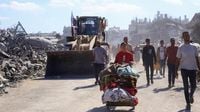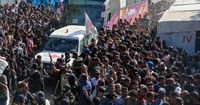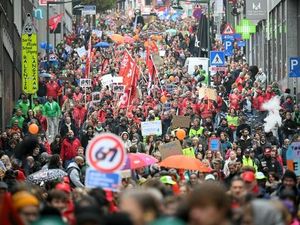On October 13, 2025, the Middle East witnessed a rare moment of hope and heartbreak as Israel and Hamas exchanged prisoners and hostages in a sweeping deal that paused two years of devastating conflict in the Gaza Strip. The ceasefire, brokered with intense international mediation, saw nearly 2,000 Palestinian detainees released by Israel in return for the freedom of 20 Israeli hostages held by Hamas since the attacks of October 7, 2023. Yet, as celebrations and somber reunions unfolded on both sides, the fragility of the truce quickly became apparent, underscoring the deep wounds and unresolved tensions that continue to define the region.
In Beitunia, a town in the Israeli-occupied West Bank, and in Khan Younis in Gaza, jubilant crowds gathered to greet the freed Palestinian prisoners. According to the Associated Press, many of the returnees flashed V-for-victory signs as they descended from International Committee of the Red Cross buses. Some were hoisted onto people’s shoulders, draped in traditional keffiyeh scarves—a symbol of Palestinian pride and resistance. Others, visibly gaunt and exhausted, simply sank into chairs, overwhelmed by the ordeal they had endured.
“It was an indescribable journey of suffering—hunger, unfair treatment, oppression, torture and curses—more than anything you could imagine,” said Kamal Abu Shanab, a 51-year-old from Tulkarem who was released after more than 18 years in prison. Abu Shanab told AP he had lost 139 pounds (59 kilograms) during his incarceration. His niece, Farah Abu Shanab, was taken aback by his appearance, remarking, “We don’t recognize him. He’s not the person we knew. Our uncle doesn’t look like our uncle.”
Among those freed were around 1,700 Palestinians seized from Gaza during the war and held without charge under Israeli law that classified them as “unlawful combatants.” Many had been detained in raids on shelters, hospitals, and at checkpoints as families fled military operations. Most were denied judicial review or access to lawyers, according to AP and NPR. The released group included two women, six teenagers under 18, and around 30 men over 60, as detailed by lists published by Hamas and reported by AP. The Palestinian Prisoners’ Club confirmed that 15 children were among those released.
Also freed were 250 Palestinians sentenced to prison terms, most for deadly attacks on Israelis dating back decades. According to Israel’s Justice Ministry, 159 of these were affiliated with Fatah, 63 with Hamas, and the rest with other groups or unaffiliated. Some high-profile prisoners, such as Marwan Barghouti—seen by many as a potential unifying Palestinian leader—remained behind bars. Israel exiled 154 of the released prisoners to Egypt, where officials said they would be sent to third countries, while the remainder returned to homes in east Jerusalem, the West Bank, and Gaza.
For many Palestinians, the issue of prisoners is deeply personal and politically charged. Nearly every family has been touched by the Israeli detention system, particularly among young men. While Israel views the prisoners as terrorists, Palestinians often see them as freedom fighters resisting occupation. Reports from the United Nations and human rights groups have highlighted harsh conditions in Israeli prisons, including isolation, beatings, insufficient food, and illness. Israel maintains that it adheres to legal standards and investigates any reported violations.
In Khan Younis, the emotional toll of captivity was evident. NPR’s Anas Baba reported that some freed detainees were so emaciated that relatives barely recognized them. Islam Ahmed, a journalist from northern Gaza who was detained by the Israeli military, described his experience: “It was miserable in Israeli prison,” he said. Ahmed recounted being beaten and humiliated, noting he lost more than 60 pounds in just 10 months.
Despite the relief of reunions, the Israeli government warned families in the West Bank not to celebrate the release, threatening arrest for any displays of support for what it termed “terrorist organizations.” According to AP, armored vehicles fired tear gas and rubber bullets to disperse crowds outside Ofer Prison. Flyers circulated in the region made clear that public celebrations could lead to detention—a stark reminder of the ongoing tensions.
For Israelis, the return of hostages was both a cause for joy and a source of pain. Thousands gathered in public squares to watch live footage of the hostages being handed over to Israeli custody by the International Committee of the Red Cross. Medical staff reported that the freed hostages were in relatively good health but had been starved, with some families telling Israeli media that their loved ones had been held shackled in isolation or underground tunnels. The NPR noted that eight bodies of deceased hostages had been handed over to Israel as of late October 14, 2025, while Hamas said it would take time to locate the remains of others, some of whom were believed to be buried under rubble from Israeli airstrikes.
The ceasefire itself was quickly tested. On October 14, 2025, at least six Palestinians were killed by Israeli forces in northern and central Gaza, according to Palestinian rescue services and hospital morgues cited by NPR. The Israeli military said those killed were approaching the line of control and were considered a threat. In a further complication, Israel reduced the amount of humanitarian aid allowed into Gaza, citing Hamas’s failure to hand over all the bodies of deceased hostages. The United Nations reported that Gaza crossings were closed, leaving hundreds of trucks with aid unable to enter the devastated territory.
The broader context of the exchange and ceasefire was shaped by high-level diplomacy. On October 13, President Trump addressed Israel’s parliament, the Knesset, to applause for his role in brokering the deal. “Israel, with our help, has won all that they can by force of arms,” Trump declared. “Now it is time to translate these victories against terrorists on the battlefield into the ultimate prize of peace and prosperity for the entire Middle East.” Later that day, Trump co-hosted a peace summit in Sharm el-Sheikh, Egypt, alongside Egyptian President Abdel Fatah el-Sisi. The meeting, attended by leaders from nearly 30 countries and major international organizations, aimed to support the next phases of the ceasefire agreement and lay groundwork for a permanent end to the war.
The summit highlighted the thorny issues that remain unresolved. Egypt’s Sisi reiterated his call for an independent Palestinian state, while Trump’s plan left open the possibility of such a state after a lengthy transition. Israeli Prime Minister Netanyahu, however, declined to attend and has repeatedly vowed never to allow the creation of a Palestinian state. The U.S.-brokered plan calls for an international body to govern Gaza, with Palestinian technocrats vetted by Israel and an Arab-led peacekeeping force. Hamas, for its part, insists that Palestinians should decide who governs them.
The cost of the war has been staggering. According to Gaza’s Health Ministry, at least 67,869 Palestinians have been killed, while the Israeli government reports 1,144 deaths from the initial Hamas-led attack. The World Bank estimates Gaza’s reconstruction will require $53 billion, and the World Health Organization says 15,600 patients need urgent evacuation, with more than 15,000 Palestinians having lost limbs due to war injuries. With winter approaching, hundreds of thousands face homelessness in a landscape of destroyed infrastructure.
As the ceasefire teeters and humanitarian needs mount, the prisoner and hostage exchange stands as both a testament to the power of negotiation and a sobering reminder of the immense challenges that remain. For families reunited and those still waiting, the road ahead is uncertain—but, for a brief moment, hope flickered amid the ruins.





